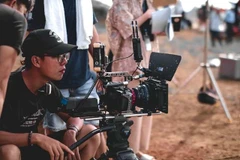Tran Cong Khanh's collection is tucked away in My Thanh An commune inthe provincial capital of Ben Tre where thousands of valuable items areplaced in order, spread out across the large house.
The 58-year-old, well-known to most local residents, was inspired andguided into the world of antiquities when he was a boy by along-standing family custom.
"To the best of mymemory, my house was full of the ancient items which were bequeathed bymy ancestors. My family settled in the royal capital city of Hue in1820. Collecting antiques was my family's tradition," he confided.
"Yet, most of the items were sold or damaged, and lost duringwartime," Khanh said, adding that his desire to maintain his family'stradition came from that time.
Since 1968, Khanhbegan seeking out old items that he fancied. He read up about antiquesand educated himself further through taking trips to museums in thearea.
"At first, I met many difficulties in comingto know the ins and outs of assessing the value of ancient items becausethere was a lack of information about antiquities. Also, I couldn'teven buy some of the items I particularly wanted because of the highprices," Khanh said.
The farmer worked to minimiseall his expenses in order to reserve money for satisfying his compulsivehobby. "To save money, I don't smoke and drink alcohol," Khanh said.
To him, each item is invaluable. "Many times, peopletried to persuade me to sell some items. Yet, I collect and restore thepieces not for re-sale. All of them have become an indispensable part oflife that I cannot live without. And I want to bequeath them to mydescendants. I hope they will also continue maintaining the family'stradition," the collector said.
"My collection is bigger than my ancestors', which brings fame to my family name, and makes me so proud and happy."
In recent years his museum has become a cultural destination for tourists, especially foreigners visiting the area.
Linh, a tour guide in the area, said that tourists mostly from France,Germany and Canada always showed interest in Khanh's collection whenthey were taken there to peruse the antiquities.
Khanh enthusiastically guides the tourists through his museum. He showsthem the ancient bronze and ceramics one by one and then presents themwith a locally made handcraft. "I often give the tourists quat mo, fansmade of spathe of areca trees, as souvenirs,"Khanh said.
Currently, his sizable collection is composed of thousands of antiquehousehold utensils mostly dating from the early 19th century and 18thcentury, such as bowls, vases, cups, clock pendulums, jars, and sets ofincense-burners.
In addition to buying pieces, toenrich his collection, the collector also managed to glue and restorebroken antiques in his house. Most of the items were made in Vietnam,China or Japan.-VNA
























